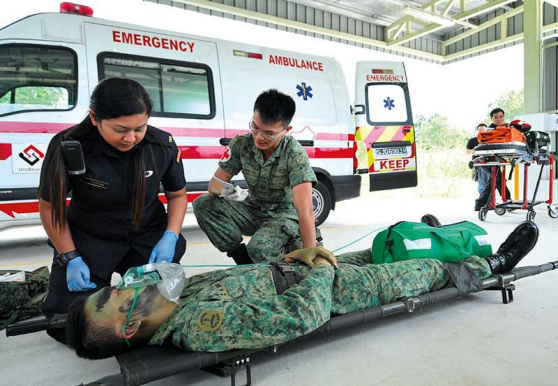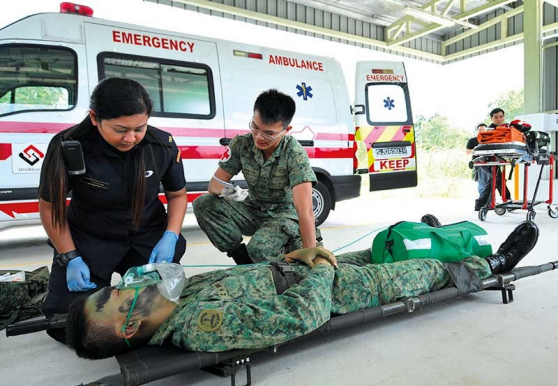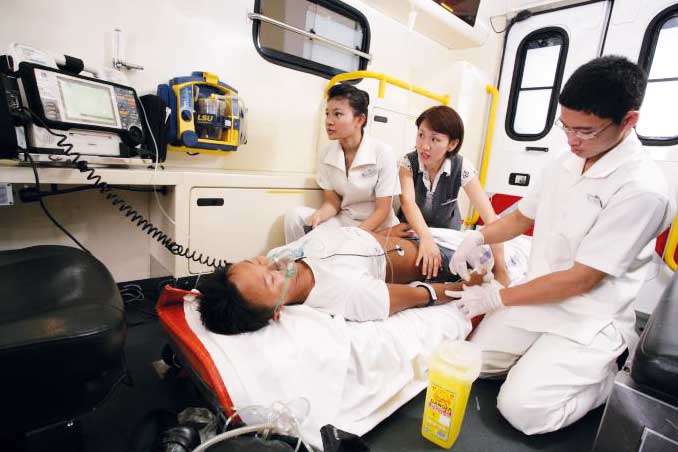OPS & TRAINING
TRAINING BOOST FOR PARAMEDICS
11 Dec 2015

The launch of a new training roadmap gives paramedics more options to upgrade their skills.
What paramedics do can make the difference between life and death. On 2 Jan, a dog handler from Tengah Air Base had a sudden cardiac arrest and was rushed to the medical centre. Thankfully, a five-man medical team - a doctor and four medics - at the medical centre were able to resuscitate him.
The successful resuscitation effort was coordinated by Senior Medic Military Expert 3 Chua Choon Lin. This was the example raised by Senior Minister of State for Defence Ong Ye Kung at the launch of the National Paramedic Training and Education Roadmap on 16 Oct at Nee Soon Camp.
"(Paramedics) are first responders to the sick and injured in the operating field. It is a critical component of emergency care (And) in the day-to-day running of all our training facilities and our camps, paramedics watch the situation to ensure that training is conducted in as safe an environment as possible."
Many roads to success
With the launch of the new training and education roadmap, paramedics can now look forward to more opportunities for professional upgrading.
In line with the national SkillsFuture movement, it is a multi-agency effort led by the Singapore Armed Forces (SAF) and the Singapore Civil Defence Force (SCDF) that charts the multiple pathways paramedics can take to pursue further studies and deepen industry-relevant skills.
It is also supported by the Ministry of Education, Ministry of Health, and the Singapore Workforce Development Agency.
Highlighting the SAF's push to certify skills servicemen have learnt, Mr Ong said: "By enhancing existing courses and by introducing new courses, (we are creating) a vocational pathway that goes all the way now to a degree qualification."
More training opportunities
Under this roadmap, paramedics can attain basic and intermediate level paramedic training through the Higher Nitec (National Institute of Technical Education Certificate) in Paramedic and Emergency Care offered by the Institute of Technical Education, or the Emergency Medical Technician and Emergency Medical Specialist courses conducted by the SAF.
After that, they can study for a Diploma in Paramedicine, then go on to study for an Advanced Diploma in Paramedicine at Nanyang Polytechnic (NYP) or a Degree with a Minor in Paramedicine at SIM University (UniSIM). The SAF will also be extending the Military Expert study award to paramedics.
Notably, these diploma and degree programmes feature an open enrolment policy that does not impose Grade Point Average (GPA) requirements.
Said Mr Ong: "So long as you are in a vocation, you can do the job, you are performing well, the path is open for you to seize."
At the event, six institutions - the SAF, SCDF, Institute of Technical Education, NYP, UniSIM, and the Justice Institute of British Columbia - also signed a Memorandum of Understanding to cement the collaboration among employers of paramedics and educational institutions to encourage skills mastery in the field.
(From left) Commissioner SCDF Eric Yap, Mr Ong, Chief of Defence Force Major-General Perry Lim and Chief of the SAF s Medical Corps, Colonel (Dr) Tang Kong Choong, at the unveiling of the plaque for the Paramedic Training and Education Roadmap.
"If you impose a GPA requirement, what it means is that your academic results long ago are going to determine your future. But here it has been done away with, because it is a vocation. So long as you are in a vocation, you can do the job, you are performing well, the path is open for you to seize." - Mr Ong about the open enrolment policy for the diploma and degree programmes in the roadmap
Milestones of paramedic training in Singapore
1996
The Defence and Home Affairs Ministries collaborated with JIBC to launch the Paramedic Training Programme in Singapore. SAF became the national institution responsible for all paramedic training
1996
SAF and SCDF sent 7 officers and combat medics to JIBC for training to become instructors
1998
The first local paramedic matriculation course was conducted at the School of Military Medicine (SAF) to a group of SAF and SCDF medics
1998-2009
SAF School of Military Medicine continues to train both SAF and SCDF paramedics
2008
ITE starts the Higher Nitec in Paramedic and Emergency Care Programme
2009
SAF Emergency Medical Specialist course gains JIBC accreditation for medic and paramedic training
2011
NYP starts the Advanced Diploma in Paramedicine course
2012
SAF and JIBC co-develop the Diploma in Health Sciences (Emergency Medical Services) and Primary Care Paramedic Programme
Who are paramedics?
Allied health professionals
First responders to the injured and sick
Operate with a crew comprising a medic and a transporter, and in pre-hospital setting, often with limited resources
Teachers/mentors to NSF medics
Paramedic Training & Education
The Singapore Armed Forces (SAF) works closely with the Singapore Civil Defence Force (SCDF) to equip paramedics with professional skills and knowledge relevant for peacetime training and operations. The National Paramedic Training and Education Roadmap is in line with the national SkillsFuture movement and provides career paramedics with multiple paths to success, regardless of their educational starting points.
Paramedic Professional Standards Committee
Looks at defining training competencies for Prehospital Emergency Care providers
| Industry stakeholders | SAF and SCDF |
| Government bodies | Unit for Prehospital Emergency Care, Ministry of Education, and Singapore Workforce Development Agency |
| Educational institutions | Institute of Technical Education (ITE), Nanyang Polytechnic (NYP), SIM University, and Justice Institute of British Columbia (JIBC) |
ALSO READ IN OPS & TRAINING

Exercise Wallaby 2025: To see better, shoot faster
31 Oct 2025
The SAF focuses on complex strike missions and multi-domain integration in Exercise Wallaby 2025, the 35th edition of its largest unilateral overseas exercise.

Ex Wallaby 25 – Greater Integration and Complexity
25 Oct 2025
The 35th edition of the SAF’s largest unilateral overseas exercise is an opportunity for expanded scale and deeper integration towards an effective, networked fighting force.

Ex Forging Sabre ramps up use of unmanned assets in integrated strike operations
12 Sep 2025
In this 10th edition of Exercise Forging Sabre, the SAF sharpened its cutting edge for the dynamic modern battlefield, with expanded integration between manned and unmanned platforms.







